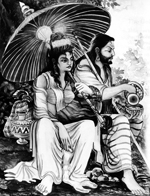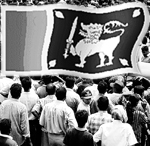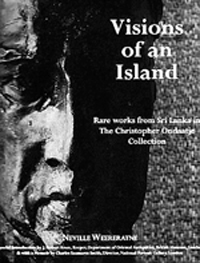|
|
|||||||||||
|
The marvel of the perahera The Festival of the Sacred Tooth by Prof. J.
B. Disanayaka Illustrated by Nihal Sangabo Dias Published by Sumitha
Publishers The back cover says this colourful little booklet is for children, but anyone, young or old, picking it up is sure to find it difficult to put down. With the historic city of Kandy the focus this week as the annual Kandy Esala perahera winds its way through the streets, we are given an opportunity to take a closer look at the perahera’s ancient traditions that hold thousands enthralled each year. For instance, how many of us are aware that more elephants at the perahera signify more rain, for they symbolise rain clouds, megha, that gather just before a downpour?
Author Prof. J. B. Disanayaka, Emeritus Professor of the University of Colombo says he hopes that ‘The Festival of the Sacred Tooth’ will “educate a new generation of Sri Lankans and foreigners on the meaning of this festival.” The booklet is the second in his continuing series to highlight the wonder that is Sri Lanka, the first being ‘The Festival of the Sun God’. The booklet explains in simple language many diverse aspects of the importance of the Sacred Tooth Relic, which “is considered the most sacred relic, because it had the closest physical contact with the sounds of speech of the Buddha, who expounded the path to Nirvana, the Eternal Bliss, over a span of forty five years, travelling across the length and breadth of the Indian sub-continent,” the author explains.
While detailing its religious and cultural significance, he makes mention of its immense political import too. It answers questions that come to mind such as why a religious relic is housed in a palace (maligawa). Because the people came to believe that the righteous King also has the power to cause rain in due season, and therefore it was kept in the King’s palace in his possession, and how in time, the people came to believe that he who possessed the Tooth Relic had the right to rule the land. Prof. Disanayaka explains in detail the many aspects
connected to the perahera: the golden casket of the Sacred Tooth
Relic, the role of the Diyavadana Nilame, the arrival of the Sacred
Tooth Relic in the island, the kings and monks who gave it importance,
and then the perahera itself, the pageant of the Four Gods, and
those without whose contribution it would not be so spell binding
– the drummers, whip crackers, dancers and the elephants.
With his many years of experience and wealth of knowledge, Prof. Disanayaka’s explanations are clear, concise and studded with fascinating detail, like the meaning of the kumbal perahera held on the first five nights, where he says, “What kumbal perahera means is a matter of guess. Some say that the word kumbal here refers to the mud-wasp who goes around an ant-hill to collect mud to build his house. Like the kumbala, this pageant also goes only around the devales without much ceremony,” unlike the Randoli perahera which parades on the main streets of Kandy. A word about the illustrations is essential, for Nihal Sangabo Dias, the well-known artist has vividly recreated the splendour and colourful spectacle the perahera presents. Unfortunately some spelling errors mar the presentation somewhat, but this little book is surely invaluable for children, who will delight in discovering many aspects of this legendary pageant and an illuminating guide to those others who value the country’s ancient traditions.
What the people have to say Ceylon to Sri Lanka: Troubled Paradise by Daya
de Silva Hardly a week passes without Sri Lankans learning that the country’s politicians or their henchmen are yet again engaged in bribery, murder and violence. Irrespective of the parties in power, the criminal activity and maladministration continue with impunity, plunging the island into further anomie and hopelessness. With the country’s institutions wallowing in nepotism, favouritism, inefficiency and corruption, some have even suggested Sri Lanka is on the verge of being a failed state – a characterisation I disagree with for various reasons. But this troubling state of affairs could be labelled “political decay,” and Daya de Silva’s new book exemplifies the frustrations and anger among some of the island’s citizens.
Most would agree that the rot began in 1956 when politicians like S. W. R. D. Bandaranaike put their political ambitions ahead of the country’s best interests. In describing the commotion the proposed Sinhala Only policy had unleashed, Bandaranaike once told an interviewer, “I have never found anything to excite the people in quite the way this language issue does.” The country continues to pay the price for such cavalier opportunism. What the Sinhala Only Act (and subsequent policies designed to ensure the majority community’s socio-economic upward mobility) gradually did was create an ethnocentric state. That has now been achieved, albeit at great cost to the country’s relative polyethnic and multireligious unity. Numerous explanations have been vouchsafed for Sri Lanka’s post-independence ethnic saga. But one explanation arguably triumphs the rest: when a country’s institutions cease to act dispassionately towards all its citizens irrespective of ethnic and religious origins, and those most adversely affected tend to be a territorialised minority, the marginalised segment may decide to go its own way. There are, of course, stages to this dangerous development, and the Tamils have run the gamut: from protesting peacefully against anti-Tamil practices; to seeking a compromise federal solution through S. J. V. Chelvanayagam’s Federal Party; to dealing with the LTTE’s terrorism. But only ideologues and apologists for successive governments deny that Tamil nationalism and its subsequent terrorism as exemplified by the LTTE are reactionary phenomena. The Tigers were not born; they were made. They were made by the ethnocentric policies perpetrated by opportunistic and unprincipled Sinhalese politicians. The majority of the Sinhalese populace initially tolerated the injustices heaped on the minorities, as they benefited from the state’s illiberal policies. But illiberalism – a situation obtained when the fundamental tenets of liberal democratic governance get undermined – cannot be compartmentalised, and it was only a matter of time before illiberal governance affected the entire island. The country has, consequently, not only suffered from inter-ethnic conflict, but also from intra-ethnic, inter-religious, inter-party, and intra-party violence. One ought to also add class conflict to this list. In short, the illiberalism that was instituted to target Tamils (both Indian Tamils and their Sri Lankan cousins) has now spread throughout the island. Over two decades of ethnic violence has ensured Sri Lanka’s Tamil community will never again be what it was; but neither will Sri Lanka. In a real sense, this is what the protagonists in Daya de Silva’s book bemoan! As one person interviewed for the book notes, “There is a belief among the Sinhala people that when a stray black cat crosses your path, terrible times await you in your future. That black cat has (now) walked across the entire island” (88). The author has interviewed numerous persons over a period of time, including relatives and friends, to articulate the concerns and experiences of ordinary and not so ordinary citizens. The book, however, is tilted towards those who are part of Sri Lanka’s upper middle class, and this inevitably elicits nostalgia for a Sri Lanka that once was to their liking and advantage. Every generation romanticises the “good old days”, although those good old days, in reality, may not have been all that good. There is an element of this in the book. But much of the book’s commentary deals with people’s recollections and perceptions of why Sri Lanka has undergone ethnic strife and political decay. In this regard the citizens interviewed here are often on the mark, with their comments representing a powerful indictment against those responsible for mal-administering the island. Post-independent Sri Lanka has been mired in ethnic violence, even as it has had to negotiate continued uneven development thanks to Sirimavo Bandaranaike’s autarky and J. R. Jayewardene’s open market policies. The subsequent income disparity among the classes, rise of the JVP and intra-Sinhalese violence, illiberal democracy, the supposed unethical conversions to Christianity, renewed ethno-religious intolerance, and challenges stemming from globalisation have only complicated matters, and these themes keep coming up in the book. The mundane issues surrounding them catalogue complaints and grievances that nearly all Sri Lankans can relate to. This book is part autobiographical, part journalistic. Daya de Silva skillfully weaves her own experiences travelling and living in Sri Lanka with the commentaries of her interviewees. She lets her subjects speak. Sri Lankans, when provided with the opportunity, especially, to discuss politics, can be brutally honest and even irreverent. This makes the book unique among recently published volumes in Sri Lanka. The book mistakenly notes that the Nonaligned Summit was held in Sri Lanka in 1971 (76). The correct year is 1976. Likewise, one interviewee claims that Mrs. Bandaranaike made a national appearance on television when she was prime minister in the 1970s to instruct how to cook “Chinese sticky rice” (170). This is impossible since television was introduced to Sri Lanka only in 1979, two years after Mrs. Bandaranaike was thrown out of office. The innovative income generation programme instituted in Bangladesh is the Grameen system, not the Praveen system (87). These minor errors notwithstanding, this is a book that many ought to enjoy and also profit from reading; for ultimately it is a frank commentary on the state of the island by some of its citizenry. When the author told one of her sources she wanted to title the book Lost Paradise, the woman retorted, “Never to be regained” (182). It is a laconic testament exemplifying how many Sri Lankans contemplate their country’s future. Perhaps the author is a little more optimistic, and hence the subtitle Troubled Paradise. Either way, it takes supreme faith to believe that this island’s extant political decay is reversible. (.)
Collecting a little piece of history Visions of an Island – Rare Works from
Sri Lanka in the Christopher Ondaatje Collection “Everything has a meaning, and everything has a reason. The very personal aspect of collecting is, I think, what makes each collection unique. Mine engulfs me. Ghosts, memories and relics of a very distant, disappearing world. A world that refuses to forget, but a world that heralds a different future. What's past is prologue.”
So says Christopher Ondaatje in the Foreword to
‘Visions of an Island – Rare Works from Sri Lanka in
the Christopher Ondaatje Collection’ authored by Neville Weeraratne.
The discerning reader is now able to enjoy this lavish production
thanks to Visidunu Prakashakayo, distributors of Ondaatje books
following the successful launch of ‘Woolf in Ceylon’
last year. The huge collection of daggers and swords, according to Knox, contains some “very fine examples of what are uniquely excellent weapons.” Nine pages are devoted to featuring swords and knives, the latter being described not only as weapons, but as symbols of culture. They are used for different purposes – for the field, for the home, for war, and for display. In the huge collection are Sri Lankan knives and swords belonging to the 17th, 18th and 19th centuries (including ‘Piha-Kaetta’), miscellaneous daggers, South Indian swords, and North Indian Bhuj Elephant knives. Then there is the ‘kastanaya’ described as the national sword of Sri Lanka, with a short curving blade and hilt ornamented with the ‘serapendiya’, a mythical, horned, lion-like beast with bulging eyes. The fascinating assortment of over 50 arecanut cutters in a variety of designs, chunam boxes, betel pounders, embroidered betel bags, and spittoons are featured in the chapter on ‘The Betel Cult’, which describes the practice of betel chewing and the use of the betel leaf as a vital part in social exchange, a gesture of hospitality and a sign of approval. Ondaaatje's collection of Portuguese and Dutch furniture includes great chests and majestic cupboards made out of jak, padouk, calamander, tamarind, satinwood and ebony. The details of brass work in these have been captured in high quality photographs. The portraits and pictures of historical events adorning the walls in the Ondaatje museum cover a wide range. He is in possession of the originals of old views of Ceylon drawn on the spot by the well-known artistes like Philippus Baldaeus, Johann Wolfgang Heydt, Carl Frederick Reimer (famous for his water colour drawing of Governor Falck's audience with the King of Kandy – 1772), Henry Salt, Lt. Charles Auber and Lt. William T. Lyttleton. James Stephanoff's drawing of the sitting of the Supreme Court reproduced as a double page spread in the book) captures vividly the numerous types of individuals in the court house, quite apart from the judge and the lawyers. The chapter on contemporary painting and sculpture gives the reader a glimpse of the valuable collection in Ondaatje's possession. It's representative of the renowned Sri Lankan painters. Among them are the work of Mudaliyar A. C. G. S. Amarasekera, Aubrey Collette, the Daraniyagalas (Justin and Ranil), Richard Gabriel, George Keyt, Ivan Peries, Sybil Keyt, Neville Weeraratne and Laki Senanayake. Tissa Ranasinghe's ‘The Dance’ and Sarath Chandrajeeva's portrait bust of Ven. Bellanwila Wimalaratane. Being a member of the ’43 Group himself, Weeraratne capsules the Group's contribution to Sri Lankan painting. The 220-page HarperCollins publication covers many more subjects and is superbly produced. Included in the book is a fine 40-page account on ‘The World of Christopher Ondaatje’. Apart from authoring the book, Neville Weeraratne has also tastefully designed it to suit the splendour of the subject matter. It's an ideal piece for the connoisseur. |
|||||||||||
Copyright © 2006 Wijeya Newspapers
Ltd. All rights reserved. |



